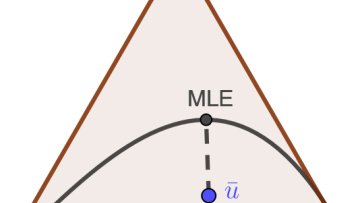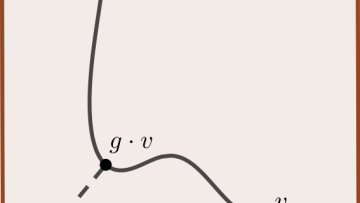Oxford Mathematician Anna Seigal talks about her work on connecting invariant theory with maximum likelihood estimation.
Oxford Mathematician Ben Green on how and why he has been pondering footballs in high dimensions.
"A 3-dimensional football is usually a truncated icosahedron. This solid has the virtue of being pleasingly round, hence its widespread use as a football. It is also symmetric in the sense that there is no way to tell two different vertices apart: more mathematically, there is a group of isometries of $\mathbf{R}^3$ acting transitively on the vertices.
11:30
Sets, groups, and fields definable in vector spaces with a bilinear form
Abstract
I will report on my recent work on dimension, definable groups, and definable fields in vector spaces over algebraically closed [real closed] fields equipped with a non-degenerate alternating bilinear form or a non-degenerate [positive-definite] symmetric bilinear form. After a brief overview of the background, I will discuss a notion of dimension and some other ingredients of the proof of the main result, which states that, in the above context, every definable group is (algebraic-by-abelian)-by-algebraic [(semialgebraic-by-abelian)-by-semialgebraic]. It follows from this result that every definable field is definable in the field of scalars, hence either finite or definably isomorphic to it [finite or algebraically closed or real closed].
The functional Breuer-Major theorem
Abstract
Let ?={??}?∈ℤ be zero-mean stationary Gaussian sequence of random variables with covariance function ρ satisfying ρ(0)=1. Let φ:R→R be a function such that ?[?(?_0)2]<∞ and assume that φ has Hermite rank d≥1. The celebrated Breuer–Major theorem asserts that, if ∑|?(?)|^?<∞ then
the finite dimensional distributions of the normalized sum of ?(??) converge to those of ?? where W is
a standard Brownian motion and σ is some (explicit) constant. Surprisingly, and despite the fact this theorem has become over the years a prominent tool in a bunch of different areas, a necessary and sufficient condition implying the weak convergence in the
space ?([0,1]) of càdlàg functions endowed with the Skorohod topology is still missing. Our main goal in this paper is to fill this gap. More precisely, by using suitable boundedness properties satisfied by the generator of the Ornstein–Uhlenbeck semigroup,
we show that tightness holds under the sufficient (and almost necessary) natural condition that E[|φ(X0)|p]<∞ for some p>2.
Joint work with D Nualart
Hybridised implicit solvers for the Gung Ho dynamical core
Abstract
[To be added to our seminars mailing list, or to receive a Zoom invitation for a particular seminar, please contact @email.]
Dense networks that do not synchronize and sparse ones that do.
Abstract
Consider a network of identical phase oscillators with sinusoidal coupling. How likely are the oscillators to globally synchronize, starting from random initial phases? One expects that dense networks have a strong tendency to synchronize and the basin of attraction for the synchronous state to be the whole phase space. But, how dense is dense enough? In this (hopefully) entertaining Zoom talk, we use techniques from numerical linear algebra and computational Algebraic geometry to derive the densest known networks that do not synchronize and the sparsest networks that do. This is joint work with Steven Strogatz and Mike Stillman.
[To be added to our seminars mailing list, or to receive a Zoom invitation for a particular seminar, please contact @email.]
Do Galerkin methods converge for the classical 2nd kind boundary integral equations in polyhedra and Lipschitz domains?
Abstract
The boundary integral equation method is a popular method for solving elliptic PDEs with constant coefficients, and systems of such PDEs, in bounded and unbounded domains. An attraction of the method is that it reduces solution of the PDE in the domain to solution of a boundary integral equation on the boundary of the domain, reducing the dimensionality of the problem. Second kind integral equations, featuring the double-layer potential operator, have a long history in analysis and numerical analysis. They provided, through C. Neumann, the first existence proof to the Laplace Dirichlet problem in 3D, have been an important analysis tool for PDEs through the 20th century, and are popular computationally because of their excellent conditioning and convergence properties for large classes of domains. A standard numerical method, in particular for boundary integral equations, is the Galerkin method, and the standard convergence analysis starts with a proof that the relevant operator is coercive, or a compact perturbation of a coercive operator, in the relevant function space. A long-standing open problem is whether this property holds for classical second kind boundary integral equations on general non-smooth domains. In this talk we give an overview of the various concepts and methods involved, reformulating the problem as a question about numerical ranges. We solve this open problem through counterexamples, presenting examples of 2D Lipschitz domains and 3D Lipschitz polyhedra for which coercivity does not hold. This is joint work with Prof Euan Spence, Bath.
[To be added to our seminars mailing list, or to receive a Zoom invitation for a particular seminar, please contact @email.]
Robust preconditioners for non-Newtonian fluids and magnetohydrodynamics
Abstract
We discuss two recent extensions of work on Reynolds-robust preconditioners for the Navier-Stokes equations, to non-Newtonian fluids and to the equations of magnetohydrodynamics. We model non-Newtonian fluids by means of an implicit constitutive relation between stress and strain. This framework is broadly applicable and allows for proofs of convergence under quite general assumptions. Since the stress cannot in general be solved for in terms of the strain, a three-field stress-velocity-pressure formulation is adopted. By combining the augmented Lagrangian approach with a kernel-capturing space decomposition, we derive a preconditioner that is observed to be robust to variations in rheological parameters in both two and three dimensions. In the case of magnetohydrodynamics, we consider the stationary incompressible resistive Newtonian equations, and solve a four-field formulation for the velocity, pressure, magnetic field and electric field. A structure-preserving discretisation is employed that enforces both div(u) = 0 and div(B) = 0 pointwise. The basic idea of the solver is to split the fluid and electromagnetic parts and to employ our existing Navier-Stokes solver in the Schur complement. We present results in two dimensions that exhibit robustness with respect to both the fluids and magnetic Reynolds numbers, and describe ongoing work to extend the solver to three dimensions.
[To be added to our seminars mailing list, or to receive a Zoom invitation for a particular seminar, please contact @email.]
System Interpolation with Loewner Pencils: Background, Pseudospectra, and Nonlinear Eigenvalue Problems
Abstract
In 2007, Andrew Mayo and Thanos Antoulas proposed a rational interpolation algorithm to solve a basic problem in control theory: given samples of the transfer function of a dynamical system, construct a linear time-invariant system that realizes these samples. The resulting theory enables a wide range of data-driven modeling, and has seen diverse applications and extensions. We will introduce these ideas from a numerical analyst's perspective, show how the selection of interpolation points can be guided by a Sylvester equation and pseudospectra of matrix pencils, and mention an application of these ideas to a contour algorithm for the nonlinear eigenvalue problem. (This talk involves collaborations with Michael Brennan (MIT), Serkan Gugercin (Virginia Tech), and Cosmin Ionita (MathWorks).)
[To be added to our seminars mailing list, or to receive a Zoom invitation for a particular seminar, please contact @email.]
12:45
Generalized symmetries and holography in ABJM-like theories -- ZOOM SEMINAR
Abstract
I will revisit the question of what is the holographic dual of N=6 supersymmetric Chern-Simons theories.





